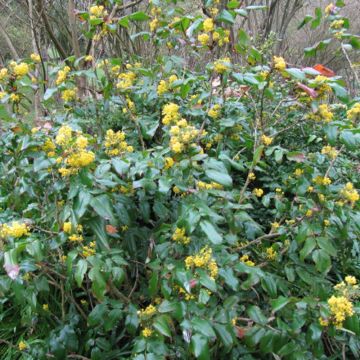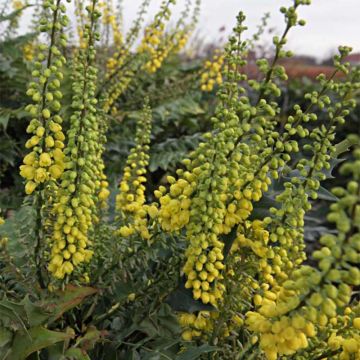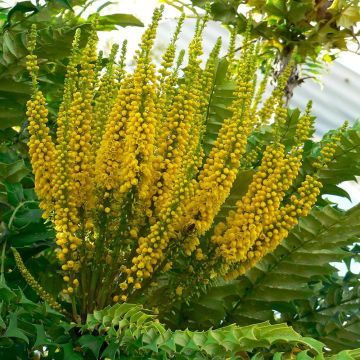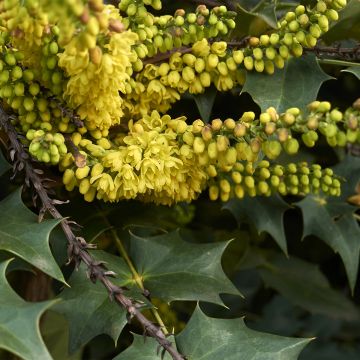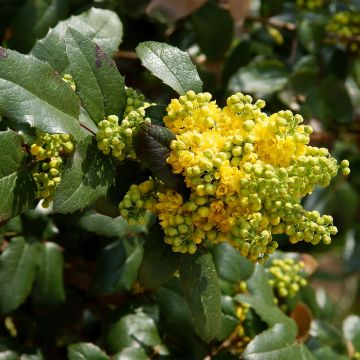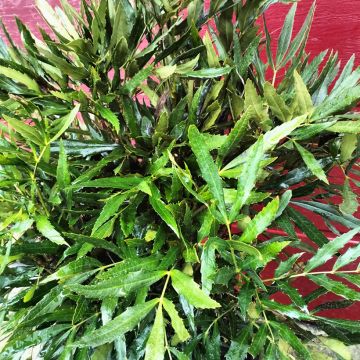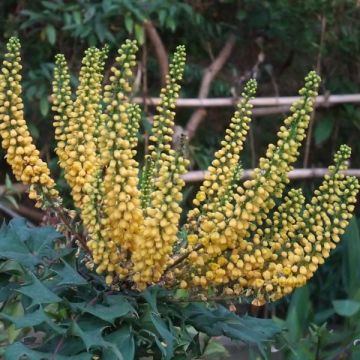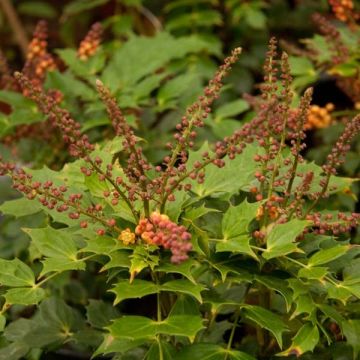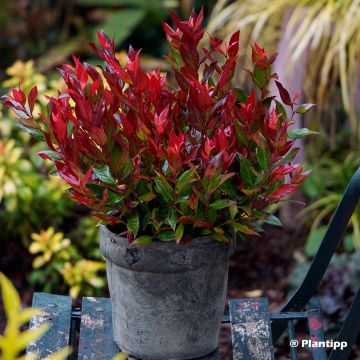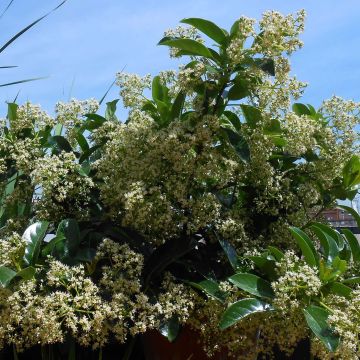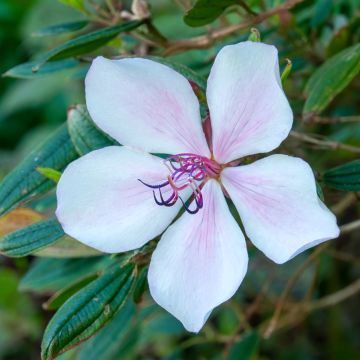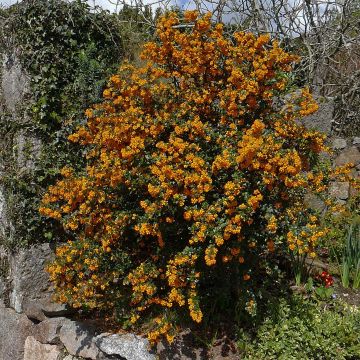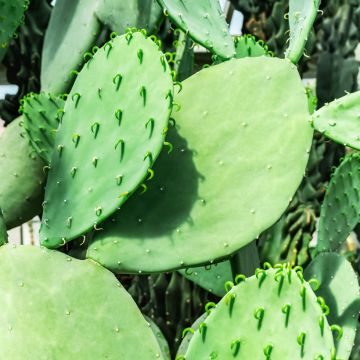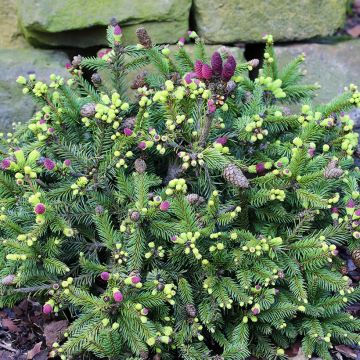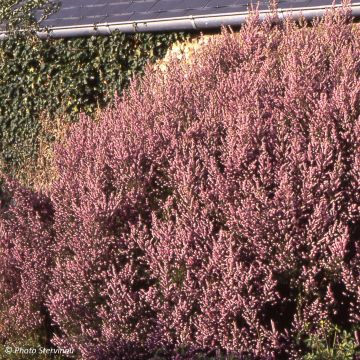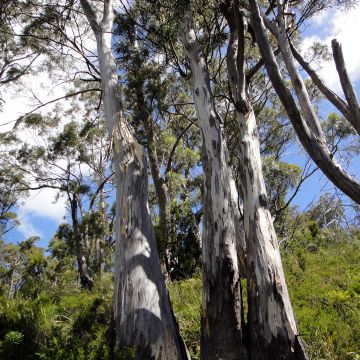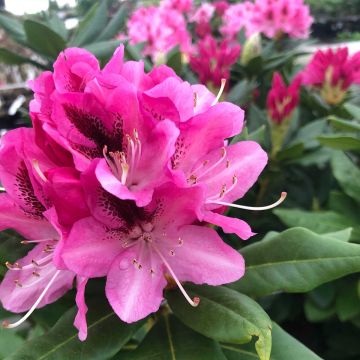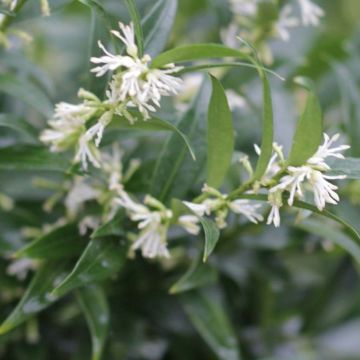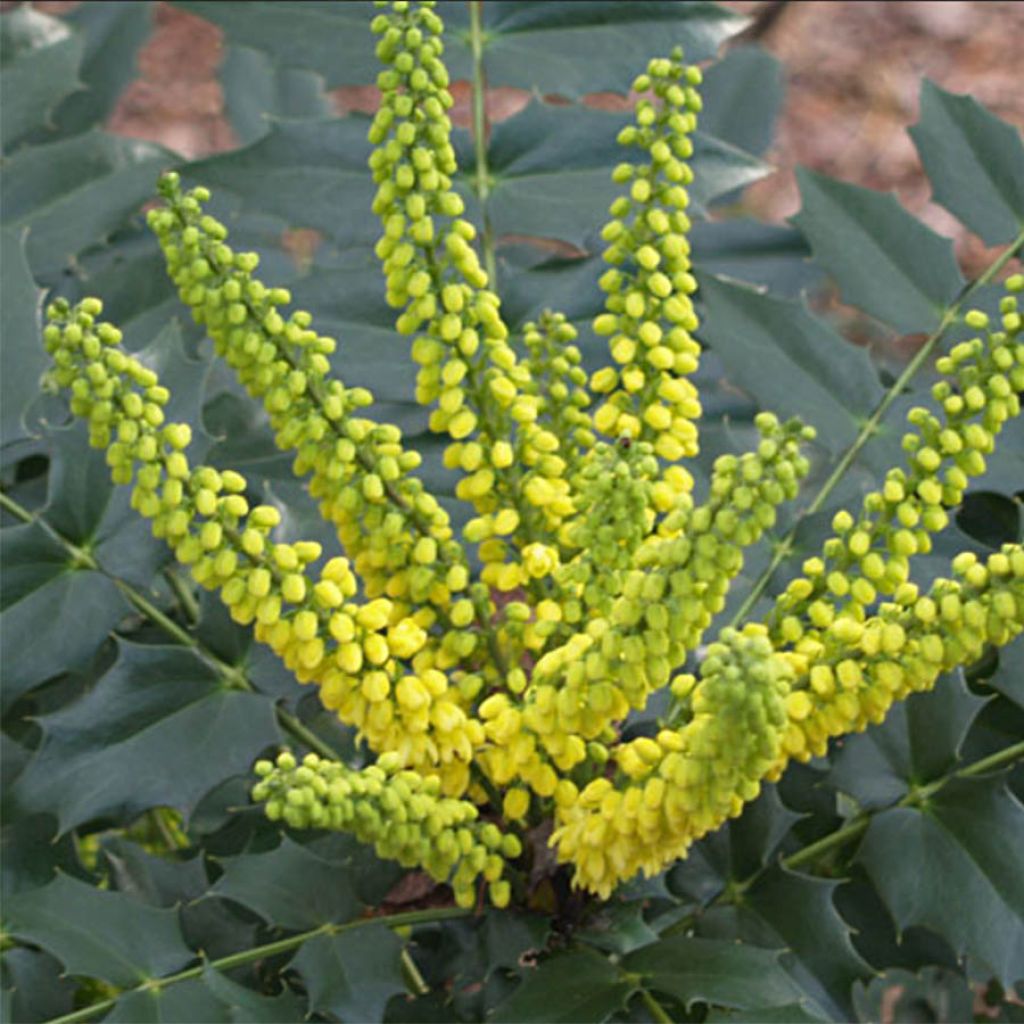

Mahonia japonica Hivernant
Mahonia japonica Hivernant
Mahonia japonica Hivernant
Japanese Mahonia
Why not try an alternative variety in stock?
View all →This plant carries a 24 months recovery warranty
More information
We guarantee the quality of our plants for a full growing cycle, and will replace at our expense any plant that fails to recover under normal climatic and planting conditions.
From €5.90 for pickup delivery and €6.90 for home delivery
Express home delivery from €8.90.

Does this plant fit my garden?
Set up your Plantfit profile →
Description
Mahonia japonica 'Hivernant', also known as Winter Mahonia, is a beautiful evergreen bush with an exotic appearance and an upright and bushy habit. It produces a splendidly fragrant winter flowering, followed by decorative purple berries.
Native to Asia and North America, Winter Mahonia belongs to the Berberidaceae family. It is a medium-sized evergreen bush, about 1.5m (5ft) in all directions, with slow growth and vigorous branches. Its habit is upright, lightly branched, and slightly spreading. Its dark green, variegated foliage with yellow veins is truly remarkable. It consists of spiny, leathery, and large leaves grouped in crowns, reaching up to 50cm (20in). It boasts sparkling and abundant winter flowering, exuding a pleasant lily-of-the-valley fragrance. From November to March, it produces large clusters of pale-yellow flowers, with a plum-coloured base. The flowers are upright and then spread out, measuring 15 to 25cm (6 to 10in). This abundant flowering is followed by the appearance of ovoid blue-purple berries, which remain on the plant for quite some time.
This splendid Winter Mahonia is a beautiful bush that can be used in shrub beds, groups, as a standalone plant, in hedges, borders, understory, or even in pots. It can be planted in partial shade or full shade, where it will brighten up the least sunny areas of the garden.
In partial shade, it will enhance Chimonanthus, Corylus avellana, or Camellia sasanqua. With its exotic appearance, it will blend in well with bamboo, other varieties of mahonia, or Japanese Aralia for a truly tropical ambiance!
In shade, it will wonderfully accompany Mexican Orange, variegated Pieris japonica, ferns, and hellebores. You can also plant it with daffodils, tulips, and wood hyacinth bulbs to add bursts of colour to its flowering!
Tip: It is possible to create a fragrant bouquet with a very contemporary look using mahonia branches. Cut the branches when the flower buds just start to turn yellow, and this sculptural floral composition will last a long time.
The genus name mahonia was chosen in tribute to Bernard Mac Mahon (1775-1816), an American botanist of Irish origin, founder of the Philadelphia Botanical Garden in the early 19th century. The first mahonias were introduced to Europe from America as early as 1823.
Report an error about the product description
Mahonia japonica Hivernant in pictures
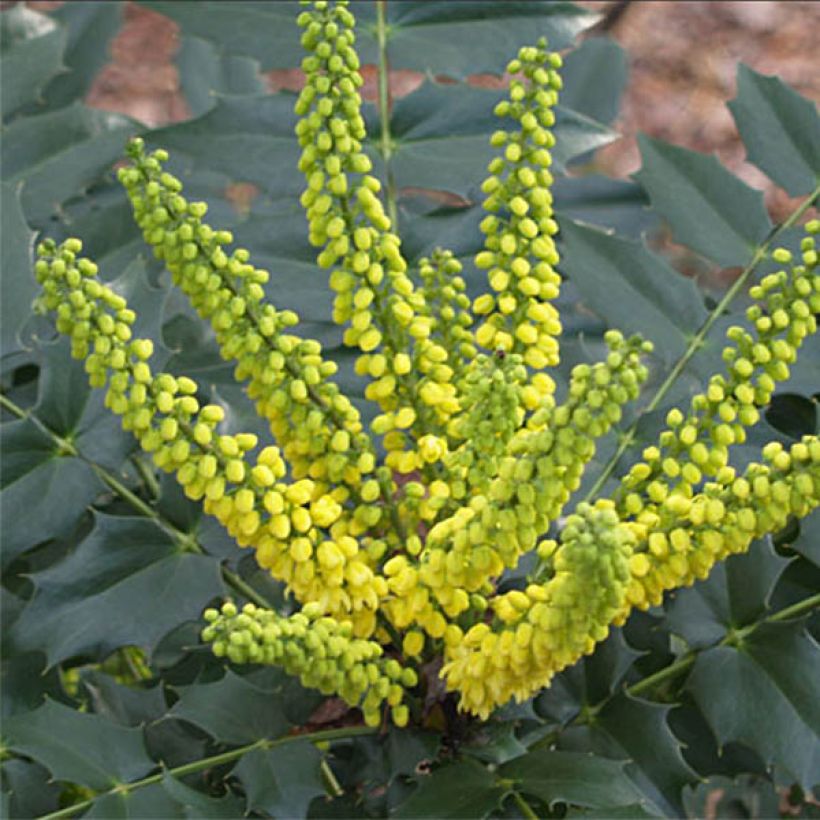

Plant habit
Flowering
Foliage
Botanical data
Mahonia
japonica
Hivernant
Berberidaceae
Japanese Mahonia
Cultivar or hybrid
Other Mahonia
Planting and care
Quite hardy, Mahonia japonica 'Hivernant' should be planted in a semi-shaded or shaded position in humus-bearing, slightly acidic, moist but well-drained soil. It can tolerate temperatures down to -15°C (5°F). It has a very long lifespan and its growth is slow. It may flower less in dense shade. After flowering, pruning consists of a light refreshment while removing branches that unbalance the habit of the plant. As mahonia tends to spread as it ages, a more severe pruning can be done to rejuvenate it. Its enemies are poorly drained soil that is too waterlogged, a position in scorching sun, and a situation that is too dry, which leads to powdery mildew attack.
Planting period
Intended location
Care
-
, onOrder confirmed
Reply from on Promesse de fleurs
Evergreen shrubs
Haven't found what you were looking for?
Hardiness is the lowest winter temperature a plant can endure without suffering serious damage or even dying. However, hardiness is affected by location (a sheltered area, such as a patio), protection (winter cover) and soil type (hardiness is improved by well-drained soil).

Photo Sharing Terms & Conditions
In order to encourage gardeners to interact and share their experiences, Promesse de fleurs offers various media enabling content to be uploaded onto its Site - in particular via the ‘Photo sharing’ module.
The User agrees to refrain from:
- Posting any content that is illegal, prejudicial, insulting, racist, inciteful to hatred, revisionist, contrary to public decency, that infringes on privacy or on the privacy rights of third parties, in particular the publicity rights of persons and goods, intellectual property rights, or the right to privacy.
- Submitting content on behalf of a third party;
- Impersonate the identity of a third party and/or publish any personal information about a third party;
In general, the User undertakes to refrain from any unethical behaviour.
All Content (in particular text, comments, files, images, photos, videos, creative works, etc.), which may be subject to property or intellectual property rights, image or other private rights, shall remain the property of the User, subject to the limited rights granted by the terms of the licence granted by Promesse de fleurs as stated below. Users are at liberty to publish or not to publish such Content on the Site, notably via the ‘Photo Sharing’ facility, and accept that this Content shall be made public and freely accessible, notably on the Internet.
Users further acknowledge, undertake to have ,and guarantee that they hold all necessary rights and permissions to publish such material on the Site, in particular with regard to the legislation in force pertaining to any privacy, property, intellectual property, image, or contractual rights, or rights of any other nature. By publishing such Content on the Site, Users acknowledge accepting full liability as publishers of the Content within the meaning of the law, and grant Promesse de fleurs, free of charge, an inclusive, worldwide licence for the said Content for the entire duration of its publication, including all reproduction, representation, up/downloading, displaying, performing, transmission, and storage rights.
Users also grant permission for their name to be linked to the Content and accept that this link may not always be made available.
By engaging in posting material, Users consent to their Content becoming automatically accessible on the Internet, in particular on other sites and/or blogs and/or web pages of the Promesse de fleurs site, including in particular social pages and the Promesse de fleurs catalogue.
Users may secure the removal of entrusted content free of charge by issuing a simple request via our contact form.
The flowering period indicated on our website applies to countries and regions located in USDA zone 8 (France, the United Kingdom, Ireland, the Netherlands, etc.)
It will vary according to where you live:
- In zones 9 to 10 (Italy, Spain, Greece, etc.), flowering will occur about 2 to 4 weeks earlier.
- In zones 6 to 7 (Germany, Poland, Slovenia, and lower mountainous regions), flowering will be delayed by 2 to 3 weeks.
- In zone 5 (Central Europe, Scandinavia), blooming will be delayed by 3 to 5 weeks.
In temperate climates, pruning of spring-flowering shrubs (forsythia, spireas, etc.) should be done just after flowering.
Pruning of summer-flowering shrubs (Indian Lilac, Perovskia, etc.) can be done in winter or spring.
In cold regions as well as with frost-sensitive plants, avoid pruning too early when severe frosts may still occur.
The planting period indicated on our website applies to countries and regions located in USDA zone 8 (France, United Kingdom, Ireland, Netherlands).
It will vary according to where you live:
- In Mediterranean zones (Marseille, Madrid, Milan, etc.), autumn and winter are the best planting periods.
- In continental zones (Strasbourg, Munich, Vienna, etc.), delay planting by 2 to 3 weeks in spring and bring it forward by 2 to 4 weeks in autumn.
- In mountainous regions (the Alps, Pyrenees, Carpathians, etc.), it is best to plant in late spring (May-June) or late summer (August-September).
The harvesting period indicated on our website applies to countries and regions in USDA zone 8 (France, England, Ireland, the Netherlands).
In colder areas (Scandinavia, Poland, Austria...) fruit and vegetable harvests are likely to be delayed by 3-4 weeks.
In warmer areas (Italy, Spain, Greece, etc.), harvesting will probably take place earlier, depending on weather conditions.
The sowing periods indicated on our website apply to countries and regions within USDA Zone 8 (France, UK, Ireland, Netherlands).
In colder areas (Scandinavia, Poland, Austria...), delay any outdoor sowing by 3-4 weeks, or sow under glass.
In warmer climes (Italy, Spain, Greece, etc.), bring outdoor sowing forward by a few weeks.

































